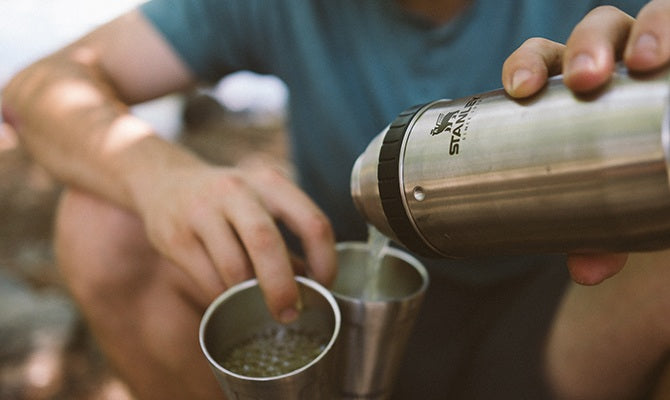
Canada is not only a beautiful place, but a delicious place, too. When you take the time to really explore the land, you start to see things a tad differently. This summer has been edible adventure after edible adventure, and sometimes it's Mother Nature who gives me a helping hand when it comes to shouting lunch.

Growing your own food or foraging from the land means you start to see the environment as the delicious place it’s supposed to be. Knowledge is definitely power here, but when you know what’s edible and more importantly, what’s not, supporting local and in-season doesn’t necessarily mean more expensive.
For me, this is what having a sense of place and taste of place is all about and there’s also something really satisfying about working for your food. So, I like to leave the recipes aside and just do what feels right – tasting and adjusting as I go along until it tastes, well, delicious! There’s something about cooking over a campfire and real food just tastes so much better.
Now, everywhere I look and every place or province I head to, there is something new to learn and feast on during our ever-changing seasons. Even though you never quite know what Mother Nature will have on her fresh sheet, one constant thing is that I have my Adventure Insulated Camp Bowls (32 oz and 18 oz) to hand for all the unexpected goodness to come.
From wild asparagus, pine and spruce, rose petals, sumac, lamb’s quarter, pineapple weed, tarragon, mustard greens, to yarrow Labrador tea, fire weed and lot and lots of poison ivy and the occasional bear spotting all of which (minus the poison ivy and you want to dodge the bear) magically edible.

With all the food stimulus around me, it doesn’t take long for me to bust out the old camp stove and Adventure All-In-One Two Bowl Cookset and set it down under a tree along the river trail or beside my tent. It is only until you unload your haul do I ever realize the extent of what Mother Nature can gift us. And then it was my turn to add a little Indian vibe and create some new food memories.
Since leaving restaurant life and the perfections that go with it, I created my own little path in food with pop up dinners across the Okanagan Valley. For me, eating in season and supporting local growers means that you need to celebrate the imperfections of it, too. That pretty much translates to the fact that I make things up based on what I find and riff on where I am. Recently, one of my favorite things to make has been a super easy salsa verde.

Foraged Salsa Verde
Ingredients:
- Spruce Tips and/or Pine Needles (these give you a fresh citrus note, especially if you bash them)
- Fireweed
- Clover
- Dandelion Tops and Leaves
- Strawberry Flowers
- Charred Garlic Clove (minced)
- Charred Green Onion and Green Tops from my camp pantry
- Olive Oil
- Vinegar or Pickle Brine
- Salt and ground Black Pepper (to taste)
Instructions:
- Tip: forage from clean places away from roads and potential pee
- Wash, then dry all your foraged greens
- Chop all the foraged things until fine and add to one of your Adventure Bowls
- Add in a glug of olive oil (or rendered animal fat if you’re hunting) and mix
- Taste and adjust the acidity with seasoning with vinegar or pickle brine or lemon/lime juice (whatever you have), as well as salt and black pepper
- Serve with glazed pork (which is what I decided to do), spiced steak, or on top of your camp tacos

Leave No Trace Chicken Soup (Serves 2 People)
Leave no trace is kind of ingrained in you when you go outside to play. I hate wasting things, so I’m always thinking about how I can use what’s left and camping is no exception.
Ingredients:
- Leftover Onion Peel from 2 large onions
- Leftover Garlic Peel
- 2 Garlic Cloves
- 2-3 Leftover Chicken Bones from chicken thighs or wings or whatever you have
Instructions:
- Start by charring the onion peel, garlic peel, and garlic cloves
- Once charred, add 500ml of water over the campfire. Bring to a boil, then let simmer for 2 hours to make a stock
- Cool and leave in your Adventure Cold For Days Outdoor Cooler
The next day, add the following to the chicken stock:
- ½ Onion (chopped)
- 1x Red Potato (small dice)
- Salt or Soy Sauce to season
- Green Onion Tops
Instructions:
- Re-heat the stock and reduce down, then add the onion and red potato
- Once the potato is cooked, add the green onion tops (you don’t want to do this too soon as green things in soups will go mushy)
- Taste and adjust seasoning with salt or soy sauce
- If you have leftovers, you can keep it warm inside a Vacuum Bottle or take it on an adventure with you

Mother Nature really does have your back.
Just remember that the land is borrowed, so don’t forget to share with the other members of our little eco-system and leave enough behind.
Happy eating!
ABOUT AMAN DOSANJ
Back to RECIPES




